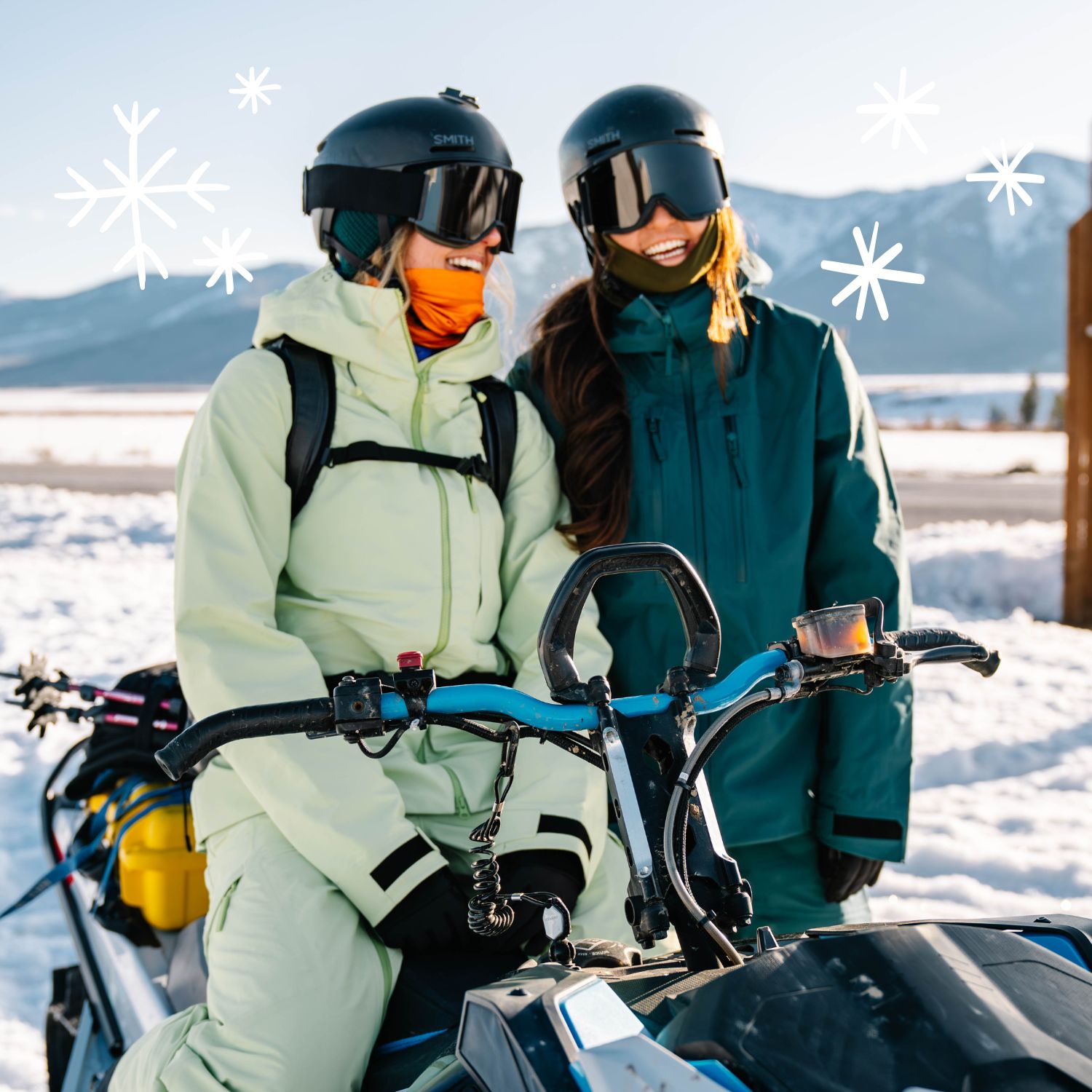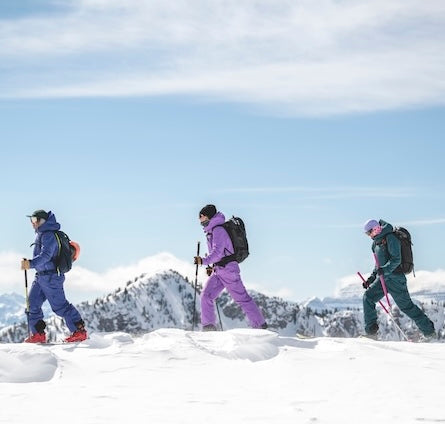
Hut Trippin': From Planning to Packing with Krystin Norman
If you haven’t gone on a hut trip before, I guarantee that once you do it will become an annual “must do” for your winter. There is nothing quite like checking out from the “normal” world and spending a full week or multiple days in the backcountry with no internet or cell phone service. Enjoying the company of a group of your closest friends and doing nothing but skiing, cooking nice meals, hitting up the sauna, and being cozy inside of a hut is good for your soul. I strongly believe that it is important to have time like this to recover from daily life and check out for a bit to reconnect with yourself and your friends. Many US states have hut systems or yurts that you can book to walk to/skin to or sometimes take snowmobiles, snowcats, or a heli in. British Columbia is also well renowned for their extensive hut system through private operations as well as the Alpine Club of Canada.

Book the Hut
Most huts need to be booked a year or two in advance. Some huts have a lottery system. My philosophy for booking a hut is that if you see an opening or have an offer to join a crew of people you like on their trip, just say yes. Book it before someone else does and if you have the cash for the deposit (usually a small percentage of the final total), there will always be a way to find people to join you. Most of the hut trips I have been on have been booked well in advance, the mid-winter or early spring before the trip happens. Say for this past year’s hut trip that I went on, I booked the hut a bit later than normal in May (I saw an opening on the website and jumped on it), and then our trip was the week before Christmas of the same year.
Other considerations when booking are whether you want your hut trip guided and/or catered. In terms of guiding, if you and your group have never been to the area where the hut is, most huts will require a guided trip or strongly recommend it. This gives you a safer experience to have folks who have experience navigating the terrain and who might be familiar with the snowpack in the area. In terms of catering, it is up to you to decide if you want a swanky trip of relaxation and not needing to think about meal planning, or if you want to go the cost-effective route and have the meal cooking as part of the fun and bonding with your friends.
Some examples of hut systems to look in to (a quick Google search of “backcountry ski huts in X location” might help):
- Alpine Club of Canada Huts
- Backcountry Lodges of BC (British Columbia)
- Yurts & Huts in the Sawtooths, Idaho
- Huts in Colorado
- Huts in Utah
- Huts in New England
- Huts and Yurts in Washington State

Find Your Dream Team
Most huts will host anywhere from 10-20 folks depending. My recommendation for selecting friends for your hut trip are to invite:
- Family who might also be your ski partners!
- Friends who you love spending down time with, drinking beers, playing board games, chilling around a fire.
- Friends who you have traveled with in the backcountry previously, or have resort skied with often. Making sure that you have good communication with your friends in terms of terrain selection, risk tolerance, and being able to openly share feelings with about the location you do or do not want to ski is crucial to a safe hut trip experience. You’ll likely need to split in to smaller groups to ski each day, so it can also help to make sure that your friends are willing to ski with each other too, and that people won’t have too much FOMO if they don’t get to ski with you every single day. Being willing to switch up groups throughout the trip gives you more time to get to know your friends and have some quality time with them on the skin track.

Planning Logistics & Group Meals
Once you dial in your group, making a sharable Google Sheet planning document for the trip that outlines all of the topics for planning:
- List of attendees going on the trip with emails and phone numbers
- Info about the hut accommodations
- Links to weather and avy forecasting website for the hut area
- Carpooling sign ups so you can all drive together
- Emergency info and contacts, for all attendees to fill out in advance
- Packing lists (individual and group shared item sign ups)
- Meal planning sign ups and any food allergy declarations
- Payment tracking (keep all of the money transparent…some people get stressed about not having clarity on where all of the money is going for the hut or food or group supplies…it is better to just keep this visible and honest)
For the meal planning, I like to have two people pair up to plan group dinners for each day. For example, myself and my husband signed up to cook dinner and dessert for the whole group of 10 for the first night of our hut trip. We listed what we were planning to cook and the ingredients that we planned to put in the meal for visibility. I have been on hut trips where a group of two is responsible for both breakfast and dinner meals in a single day meaning that you have to wake up early to cook breakfast, and also come back early from skiing to cook dinner), but I personally like to have breakfast and lunch as communal ingredients that are available for folks to make whatever they feel like having that day. In terms of dishes, I think it is most fair to have people who did not cook the meal that evening take care of cleaning up the dishes and resetting the kitchen. Chat with your group on what they prefer and if there are types of lunch and breakfast options that they generally prefer.
For group shopping, it is best to have one person take care of all of the payments and then they can request Venmo reimbursement split equally by all parties.
Hut trip insurance and accidental rescue insurance are important things to consider. If there is something that happens and your crew cannot go, it will be nice to have a peace of mind that you are covered for your expenses. Rescue insurance can be coordinated through many companies, and groups like the American Alpine Club offer membership at a higher tier including rescue insurance. Something to look into as a “just in case”.

Packing Your Gear
I am the type of person who has packing lists for each type of ski touring outing situation I might go on, but I think it is important to consider a few things for hut trip packing since you are bringing more than just clothing:
- Pack your clothing in a duffle bag that is fairly snow/water resistant and durable. I like the Patagonia black hole duffel bags for my traveling and hut trips because your bag might end up sitting in the snow or rain for a long time and you’ll want your stuff to stay dry.
- Communal food and small items should be packed in durable cardboard boxes or plastic bins that are medium sized and reasonable to pick up and put into the heli or on to a sled for transport. Make sure the boxes are taped shut and not loose or easy to open. Grocery bags won’t cut it and will break open in transport.
- Bring one extra pair of skis (with demo bindings if possible) or splitboard for the group and one extra set of poles. It would be unfortunate to have a gear malfunction while you are in the middle of nowhere and not be able to ski for a full week because of broken gear!
- Pack communication tools like radios, GPS devices, and communication tools like an In-Reach. It is nice to have ways to share conditions while out skiing each day to make sure everyone is safe and sound, and a way to contact help from outside if there is an emergency.
- Have people sign up to bring some of the shared group items so that you don’t have too much of one thing.
- Bring stuff to do for indoors. You’ll have a lot of downtime for board games, reading books, or listening to music!
- Some huts have saunas and possibly a way to heat water to take a shower! This is a perfect opportunity to use your Wild Rye Camp Towel!
- I like to check the weather in advance and take screen shots on my phone of the weather forecast before I decide what ski layers to bring. I generally love to use my merino wool Evie Raglan and Jane Leggings because they don’t smell bad from multiple days of ski touring, and they keep me warm and dry.
- Bring a comfy outfit for downtime! There is nothing better than putting on some dry and warm cotton and sitting by the fire with a mug of tea after a long day of ski touring. I have been packing my Tallac Turtleneck and Helen’s Hoody for après chilling on hut trips.
- Pack something comfy and cozy to leave in your vehicle for when you get out of the hut. After a week of wearing the same limited number of outfits for a full week, you will really want some clean and cozy clothing. I always pack an extra bag that I leave in our truck with some cozy clothes to put on once we fly out of the hut and get back to civilization.
Here is my packing list:


Have Fun and Go On a Hut Trip Annually
If you’re on the fence about a hut trip, I highly recommend to commit to one and go! Maybe don’t plan your first hut trip before ever going on one, but see if you have friends looking to fill spots and tag along. The experience of bonding with friends in the wilderness and checking out of normal life obligations for a bit is pretty special and you’ll probably find it is something that you want to integrate into your yearly winter routine. Enjoy!!!
BY KRYSTIN NORMAN



![[Saffron] Danner 3/4 Zip saffron yellow flatlay](http://wild-rye.com/cdn/shop/files/DANNER_SAFFRON.jpg?v=1764970727&width=2160)
![[Saffron] Danner 3/4 Zip Saffron yellow front crop view](http://wild-rye.com/cdn/shop/files/WILDRYE4908.jpg?v=1764970727&width=2048)
![[Amethyst] Heyburn 3L Jacket in amethyst, flatlay](http://wild-rye.com/cdn/shop/files/WildRye_HeyburnJacket_Amethyst_1.jpg?v=1759164917&width=2048)
![[Amethyst] Heyburn 3L Jacket in amethyst, on model front crop view](http://wild-rye.com/cdn/shop/files/WILDRYE6636.jpg?v=1759165998&width=2048)
![[Shaded Spruce] Heyburn 3l bibs in shaded spruce, flatlay](http://wild-rye.com/cdn/shop/files/WildRye_HeyburnBib_Spruce_1.jpg?v=1759173988&width=2048)
![[Shaded Spruce] Heyburn 3l bibs in shaded spruce, on model front full body view](http://wild-rye.com/cdn/shop/files/WILDRYE6166.jpg?v=1759173988&width=2048)
![[Olive You] Freyah Pant Olive flatlay](http://wild-rye.com/cdn/shop/files/FREYA_OLIVEYOU.jpg?v=1757356787&width=2160)
![[Olive You] Freyah Pant Olive front full body view](http://wild-rye.com/cdn/shop/files/WILDRYE3613.jpg?v=1757436391&width=1815)
![[Storm Contour] Bassett Half zip in storm purple with light purple floral pattern, flatlay](http://wild-rye.com/cdn/shop/files/BassettHalfZip_StormContour.jpg?v=1757965879&width=2160)
![[Storm Contour] Bassett Half zip in storm contour, on model front crop view](http://wild-rye.com/cdn/shop/files/WILDRYE4159.jpg?v=1757965879&width=2048)
![[Chestnut Storm] Brown baselayer legging with purple colorblocked stripe on each leg, flatlay](http://wild-rye.com/cdn/shop/files/BassettLegging_Chestnut.jpg?v=1757963384&width=2160)
![[Chestnut Storm] chestnut storm blocked baselayer legging, on model front crop view](http://wild-rye.com/cdn/shop/files/WILDRYE4041.jpg?v=1757963384&width=2048)
![[Shaded Spruce] Payette insulated pullover in shaded spruce, flatlay](http://wild-rye.com/cdn/shop/files/WildRye_PayettePullover_Spruce_1.jpg?v=1758837674&width=2048)
![[Shaded Spruce] Payette insulated pullover in shaded spruce, on model front crop view](http://wild-rye.com/cdn/shop/files/WILDRYE5759.jpg?v=1758838275&width=2048)
![[Iris] Payete Insulated Pant in Iris purple with floral contrast stitching, flatlay](http://wild-rye.com/cdn/shop/files/WildRye_PayettePant_Iris.jpg?v=1758840409&width=2048)
![[Iris] Payette Insulated Pant in Iris purple, on model front crop view](http://wild-rye.com/cdn/shop/files/WILDRYE5496.jpg?v=1758840409&width=2048)





Leave a comment
This site is protected by hCaptcha and the hCaptcha Privacy Policy and Terms of Service apply.